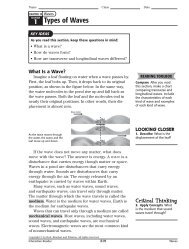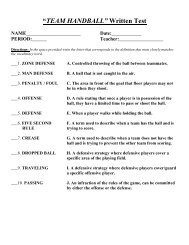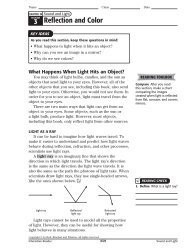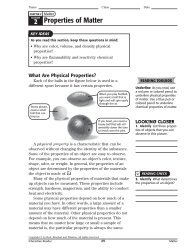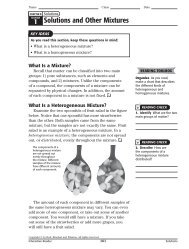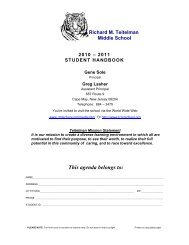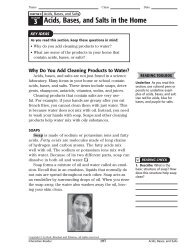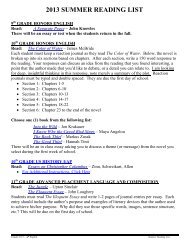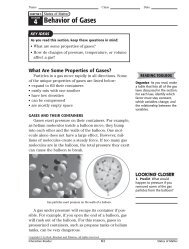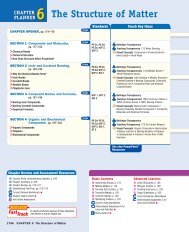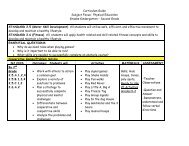7.4 Reaction Rates Interactive Guide - Lower Cape May Regional ...
7.4 Reaction Rates Interactive Guide - Lower Cape May Regional ...
7.4 Reaction Rates Interactive Guide - Lower Cape May Regional ...
Create successful ePaper yourself
Turn your PDF publications into a flip-book with our unique Google optimized e-Paper software.
introductionDear ownerThank you for deciding to buy one of ournew motorhomes. We are sure you will enjoymany happy hours in it and we hope theinformation and hints in this handbook willheighten your enjoyment.The handbook has been designed to giveyou a general guide to the care, use andmaintenance of your motorhome.Whether you are a new or an experiencedmotorhome user the hints will help to protectyour investment.The information contained will answer mostof your queries, but if there are any aspectswhich are not covered please consult yourappointed dealer.Happy touring!Important - please quote the base vin(vehicle identification number) in allcorrespondence with your dealer orSwift Group Limited (Swift), this can befound on the lower corner of the frontwindscreen or on the Fiat/Peugeot platepositioned on the front cross memberwithin the engine compartment .All the illustrations and descriptive matter inthis handbook are intended to give a generalidea of the motorhome. Changing marketand supply situations may prevent us frommaintaining the exact specification detailsin this handbook. We therefore reserve theright to alter specifications as materials andconditions demand.Dealers are not agents of Swift Group Limitedand have absolutely no authority to bindSwift Group Limited by any express or impliedundertaking or representation.introduction1
Name Class DateSECTION 4<strong>Reaction</strong> <strong>Rates</strong> and Equilibrium continuedA DYNAMIC PROCESSChemical equilibrium is a dynamic process. That is,changes happen all the time. However, when a changeis made, the chemical reaction adjusts to maintainequilibrium.Consider the Haber process, which is used to makeammonia, NH 3. Ammonia is a chemical used in fertilizers,dyes, plastics, cosmetics, cleaning products, and fireretardants. The Haber process is shown in the followingequation.N 2(gas) + 3H 2(gas) ⇆ 2NH 3(gas) + energyNotice that the process is reversible. However, manufacturerswant more NH 3than N 2or H 2. In other words,they want to change the equilibrium so that the right sideof the equation is favored. Some conditions that affectequilibrium are shown below.The Effects of Change on EquilibriumConditionTemperaturePressureConcentrationEffectIncreasing temperature favors thereaction that absorbs energy.Increasing pressure favors thereaction that produces fewermolecules of gas.Increasing the concentration of onesubstance favors the reaction thatproduces less of that substance.13. Apply Concepts Whatcould you do if you wantedto favor an endothermicreaction?LE CHÂTELIER’S PRINCIPLELe Châtelier’s principle is a general rule that describeshow equilibrium systems respond to changes.Le Châtelier’s principleIf a change is made to a system atchemical equilibrium, the equilibriumshifts until the system reaches a newequilibrium.Look again at the equation for the Haber processabove. Recall that increasing pressure favors the reactionthat produces the fewer gas molecules. Thus, if youincrease pressure, the equilibrium shifts and the rightside of the equation is favored. As a result, more NH 3forms. For this reason, the Haber process is carried outunder extremely high pressure.14. Apply Concepts Whatfactor would you changein the Haber process if youwanted to favor the left sideof the equation? Explain youranswer.(Hint: Use the table in thetext above.)Copyright © by Holt, Rinehart and Winston. All rights reserved.<strong>Interactive</strong> Reader 159 Chemical <strong>Reaction</strong>s
Name Class DateSection 4 ReviewSection Vocabularycatalyst a substance that changes the rate of achemical reaction without being consumed orchanged significantlychemical equilibrium a state of balance inwhich the rate of the forward reaction equalsthe rate of the reverse reaction and the concentrationsof products and reactants remainunchangedenzyme a molecule, either protein or RNA, thatacts as a catalyst in biochemical reactionssubstrate the reactant in reactions catalyzed byenzymes1. List Identify five factors that may affect the rate of a chemical reaction.2. Explain If you add a piece of potato to hydrogen peroxide, tiny gas bubbles willform. However, if you crush the piece of potato first, more gas bubbles will form.Explain these observations.3. Compare What is the relationship between a catalyst and an inhibitor?4. Predict How will an increase in pressure affect the following chemical equilibrium:2NOCl (gas) ⇆ 2NO (gas) + Cl 2(gas)? Explain your answer.5. Evaluate Assumptions A person tells you that a reaction must have stoppedbecause the amounts of products and reactants have not changed. What is wrongwith the person’s reasoning?Copyright © by Holt, Rinehart and Winston. All rights reserved.<strong>Interactive</strong> Reader 160 Chemical <strong>Reaction</strong>s



